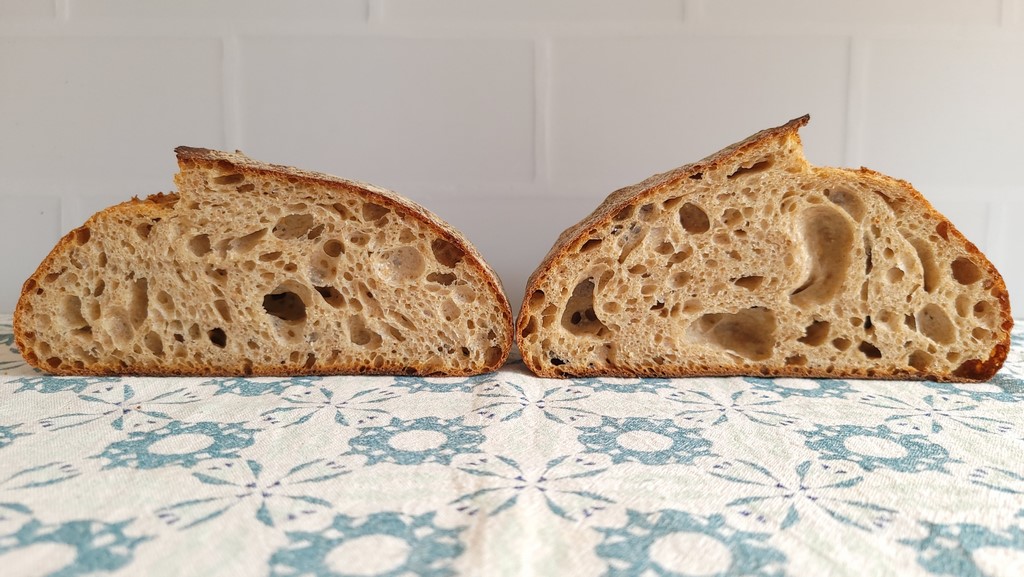This experiment appears to be like at shaping dough earlier versus later within the rising course of. Dough rising — aka fermentation — might be depicted as an upward trending curve on a graph, with dough growth on the y-axis and time on the x-axis. The road begins out flat-ish, will get more and more steeper, after which flattens once more. (Ideally your dough is within the oven or fridge earlier than the flattening of the curve.)
(Fictional graph information for instance the thought – not an actual dough growth sequence)
The aim of this double bake experiment is to evaluate the affect on crumb, loaf top, and rating bloom of ending the majority fermentation at completely different factors on the curve. The entire fermentation of the 2 doughs is similar, however one dough has a shorter bulk fermentation and an extended ultimate proof and the opposite an extended bulk fermentation and shorter ultimate proof.
It is very important perceive that the outcomes and conclusions of this experiment — how far you wish to push the fermentation throughout every stage of rising — will not be relevant to different flours, dough hydration and temperature, and dealing with (gluten improvement and shaping methodology). For instance, dough that’s comprised of low-gluten flours is much less in a position to maintain massive, stretched bubbles in its construction, so it might seem flatter than a high-gluten dough with the identical diploma of fermentation. That is to say that this identical experiment accomplished with all entire grain purple fife flour would seemingly be taller if formed and baked at much less dough growth. In the meantime, an all bread flour dough or a a lot dryer dough, might be formed earlier and proofed longer and nonetheless keep its form.
Formed earlier (left); formed later (proper)
Technique
Baker’s Percentages
62% bread flour
38% purple fife entire grain flour or dwelling milled purple fife wheat berries
75% water
12.5% sourdough starter
1.8% salt
The double-batch of dough on this experiment had 500 grams bread flour and 300 grams purple fife entire grain flour. After a radical mixing it was divided into two straight-walled buckets and an aliquot jar to trace the whole growth of the dough from mixing to oven.
The phrase “aliquot” means a pattern or part of a complete. Within the context of baking bread, it’s a small portion of a bigger dough that you just place in a small straight-walled container after mixing. After marking the preliminary degree of the aliquot, you’ll be able to observe its growth to assist resolve when to form and bake the primary dough. If different variables are saved fixed, over a number of bakes you’ll be able to assess how completely different ranges of growth within the aliquot jar affect the ultimate loaf.
Simply after mixing
The doughs had two rounds of stretching and folding throughout the first hour of the majority fermentation, and all the pieces was saved in a proofing field at 77°F.
Time to form Dough 1 (60% growth)
Time to form Dough 2 (90% growth)
Curiously, the growth of the aliquot dough lagged behind the growth of the bread doughs of their buckets, maybe as a result of all of the dough began within the low 80s, and the aliquot cooled to the proofing field temp of 77°F sooner on account of its smaller thermal mass. The temperature of all three was equal inside about 50 minutes of a 7-hour course of (mixing to oven), so this discrepancy stays a little bit of a thriller.
Dough 1 had a shorter bulk fermentation and was formed at 60% growth (40% aliquot growth).
Dough 2 had an extended bulk fermentation and was formed at 90% growth (60% aliquot growth).
The doughs have been formed gently and didn’t have a pre-shape and bench relaxation. They went into the oven when the aliquot dough was at 80% growth. Trying on the distinction between the dough buckets and the aliquot, the whole dough growth at oven time “in bucket phrases” was most likely 120%.
Outcomes
Dough 1, on left, had the shorter bulk fermentation and longer ultimate proof. This bread has a extra engaging honeycomb crumb, however is flatter with much less rating bloom.
Dough 2, on proper, had an extended bulk fermentation and shorter ultimate proof. This bread has a much less even crumb with some tighter areas and a few bigger holes, however it’s taller and had extra rating bloom.
Conclusions
This experiment reveals that shaping at pretty completely different occasions on the fermentation curve can produce good loaves of bread. Relying in your objectives, you’ll be able to play with the timing, in addition to regulate different elements of your course of, to attain completely different crumb and loaf top.
For this mixture of flours and at this hydration, at my subsequent bake, I would repeat the timing of Dough 1 however check including a pre-shape and bench relaxation in hopes of strengthening the form for that longer ultimate proof. Or I would finish the majority fermentation in between the timing of Dough 1 and a pair of, at 75-80% growth, and once more form gently with no pre-shape. To reach at this identical whole fermentation of the dough, I would wish to make use of an aliquot jar once more and assess once more the way it expands in contrast with the primary dough.

